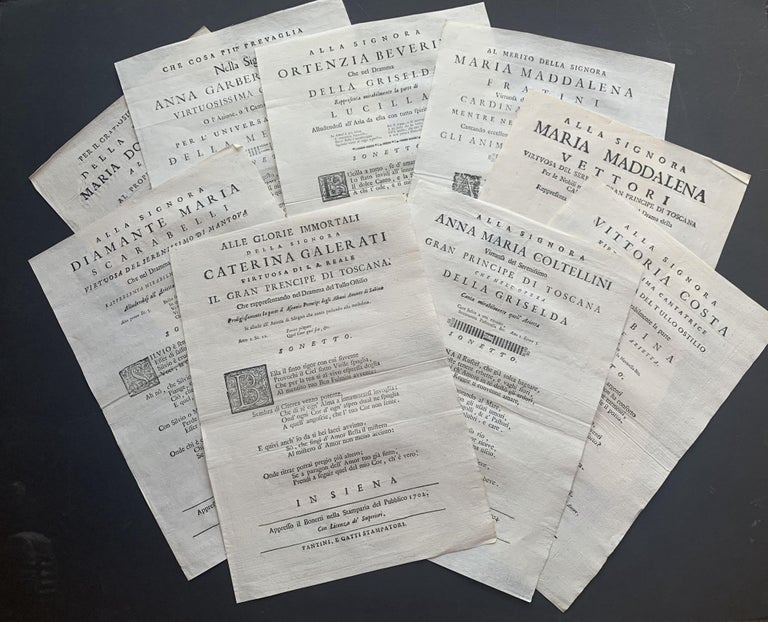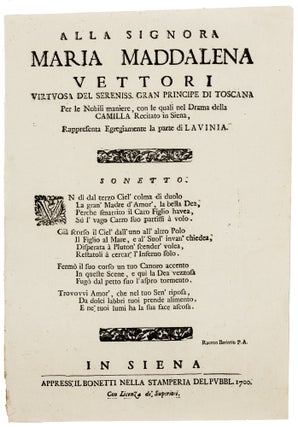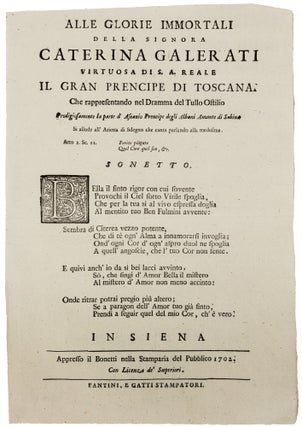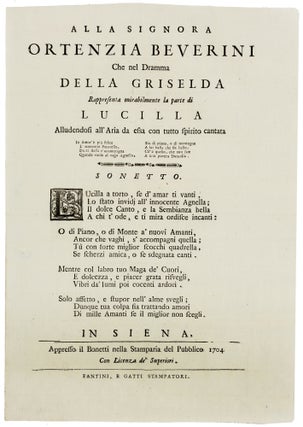1. Alla signora Maria Maddalena Vettori... In Siena, appress' il Bonetti nella Stamperia del Pubbl. 1700. 2. Per il gratiosissimo canto della signora Maria Domenica Pini... In Siena Appress' il Bonetti nella Stamperia del Pubbl. 1700. 3. Alla signora Diamante Maria Scarabelli... In Siena Appresso il Bonetti nella Stamparia del Pubblico 1702. 4. Alla Signora Vittoria Costa... In Siena Appresso il Bonetti nella Stamparia del Pubblico 1702. 5. Alle glorie immortali della signora Caterina Galerati... In Siena Appresso il Bonetti nella Stamparia del Pubblico 1702. 6. Alla signora Ortenzia Beverini... In Siena, Appresso il Bonetti nella Stamparia del Pubblico 1704. 7. Alla signora Anna Maria Coltellini... In Siena, Appresso il Bonetti nella Stamparia del Pubblico 1704. 8. Che cosa più prevaglia nella signora Anna Garberini Benti... In Siena, Appresso il Bonetti nella Stamparia Pubblico 1704. 9. Al merito della signora Maria Maddalena Fratini... In Siena, Appresso il Bonetti nella Stamparia del Pubblico 1704.
Each broadside measures 26 x 37 cm, with recto printed and verso blank. Ornamented initials in the first word of each sonnet. Nine broadsides with laudatory sonnets addressed to female singers, who were featured in several opera productions in Siena (Italy) from 1700 to 1704. These materials are not only an invaluable source for the history of Italian opera, but also offer an understanding of the position of women in Italian opera and society in the Early Modern period. Siena, just forty-four miles south of Florence, was a peripheral opera center. Despite its proximity and political ties with Florence, where opera flourished all throughout the seventeenth century, Siena did not see its first operatic production until 1669. At the time of the publication of these broadsides, it was already part of an international opera circuit. The broadsides include the names of the signers, the titles of operas, and the singers' parts in them. In several cases, patrons of the singers are mentioned: a Medici Cardinal, the Duke of Mantua, and the Grand Duke of Tuscany. All the nine broadsides were published in the printing shop at the venue of the theatrical production-the Palazzo Pubblico. Such broadsides were commonly distributed during and/or after the run of an opera to create publicity for the production and satisfy the admirers of singers. The standing of women in early eighteenth-century opera was rather precarious. To quote Rosselli, "exposure to men was the trouble -- not just to men in the audience but to fellow-workers in the theatre. In Italy as in other Mediterranean countries, respectable women were meant to be seen, if at all, at home or in a few public places, especially in church, accompanied by relatives or duennas... Women singers in the early days of opera, then, existed as objects of male expectancy, at once dubious and entrancing." [Rosselli, Singers of Italian Opera, pp. 56-59] We know that at least three women mentioned in the broadsides-- Maria Maddalena Fratini, Anna Maria Cortellini, and Garberini Benti--struggled to maintain professionalism amidst an atmosphere of harassment in Siena. To quote Reardon: "If the relationships among cast members were calm and professional, the same could not be said for the interactions among members of the Sienese community regarding female singers... Maria Maddalena Fratini had also attracted a fervent admirer in Michelangelo Mendolla, the brother of the man in charge of the armed forces stationed at Siena's fortress. Again, the cardinal had to write to the Auditore not once, not twice, but three times, to insist that Mendolla be forbidden from entering Fratini's house. Finally, there was bad blood between partisans of the two leading ladies. The German Count Lamberghi and other young men of the German nation who were a constant presence in Siena took up the protection of Coltellini after some Italian noblemen, ardent fans of Garberini Benti, were heard whistling when Coltellini was singing." [Reardon, A Sociable Moment, pp. 249-250] The first two broadsides sing praises to the only two female singers in Cammilla, regina de’ Volsci--Maria Maddalena Vettori (La Marsoppina) and Maria Domenica Pini (la Tilla) (1670/71-1746). The latter was a Florentine soprano, who was "so much admired by her patron, Prince Ferdinando de' Medici, that he would later ask the composers Alessandro Scarlatti and Giacomo Petri to rewrite roles so as to make them more suitable for her" [Reardon, A Sociable Moment, p. 212]. The production also marked the début of the singer who would later become known as the "Great Sienese," Francesco Bernardi [Reardon, A Sociable Moment, p. 208]. The third, fourth, and fifth broadsides mention Il Tullo Ostilio, an opera first staged in Pisa and Florence in 1701 under the patronage of the Medici court. The main female parts in the Sienese production were given to Diamante Maria Scarabelli (fl. 1692-1718), at the time a rising star, Vittoria Costa (fl. 1701-1719), and Caterina Galerati (fl. 1701-21)--the latter two only at the beginning of their careers. The sixth and seventh broadsides were issued to celebrate the performances of Ortenzia Beverini, a singer from the court of Francesco Maria de' Medici, and Anna Maria Cortellini, in Griselda. The eighth sonnet sings praises to Maria Anna Garberini Benti [Bulgarelli] (La Romanina) (1684-1743), a singer recommended by Prince Agostino Chigi, for whom it was the first appearance in an opera [Reardon, A Sociable Moment, p. 247]. The ninth broadside praises Maria Maddalena Fratini, another Medici singer from Florence. We could not locate any copies of these works in the OCLC and KVK. References: Reardon, A Sociable Moment: Opera and Festive Culture in Baroque Siena (2016); Rosselli, Singers of Italian Opera (1992); Grove Music Online.
Sold




